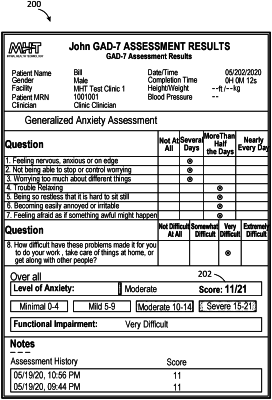| CPC G16H 50/30 (2018.01) [G06N 3/02 (2013.01); G16H 10/20 (2018.01); G16H 10/60 (2018.01); G16H 40/20 (2018.01); G16H 50/70 (2018.01)] | 20 Claims |

|
1. A computer implemented method for allocating resources in mental health treatment, comprising:
executing, by at least one processor on a computing layer, an algorithm stored on a non- transitory computer-readable memory medium that communicates mental health treatment resources allocation after analyzing to a healthcare provider, wherein the mental health treatment resources allocation comprising:
retrieving, from a database layer that stores individual patients' profiles and corresponding electronic medical record, a patient's mental health assessment data stored according to a profile of the patient, wherein the patient's mental health assessment data comprises a plurality of symptoms categories data that have been mapped to one or more assessed mental conditions;
computing, a wellness score for the patient, by aggregating each and every individual weighted score of the mapped assessed mental condition of the patient;
determining, an overall treatment efficacy progress for the patient, by statistically analyzing a gradient of the computed wellness scores of the patient over a time duration;
aggregating, over a pool of patients population with similarly mapped assessed mental conditions, a distribution of the gradient of the computed wellness scores of an overall treatment efficacy progress;
sampling over a defined range of the distribution of the gradient of the computed wellness scores of the overall treatment efficacy progress to determine a correlation coefficient of fixed factors and variable factors that affect the overall treatment efficacy progress within the pool of patients population, wherein the fixed factors are factors that do not change from assessment to assessment while variable factors are factors that can change from assessment to assessment;
using both the correlated coefficient of fixed factors and variable factors to compare or adjust treatment efficacy results over a range of available mental health treatment resources including resources that have not been previously allocated in order to determine a next mental health treatment regimen with an optimal overall efficacy progress over a next time duration for the patient;
communicating the next mental health treatment regimen, along with a level of confidence factor, to a healthcare provider for requesting the resources for the patient and
distributing assessments to patients or designated intermediaries.
|